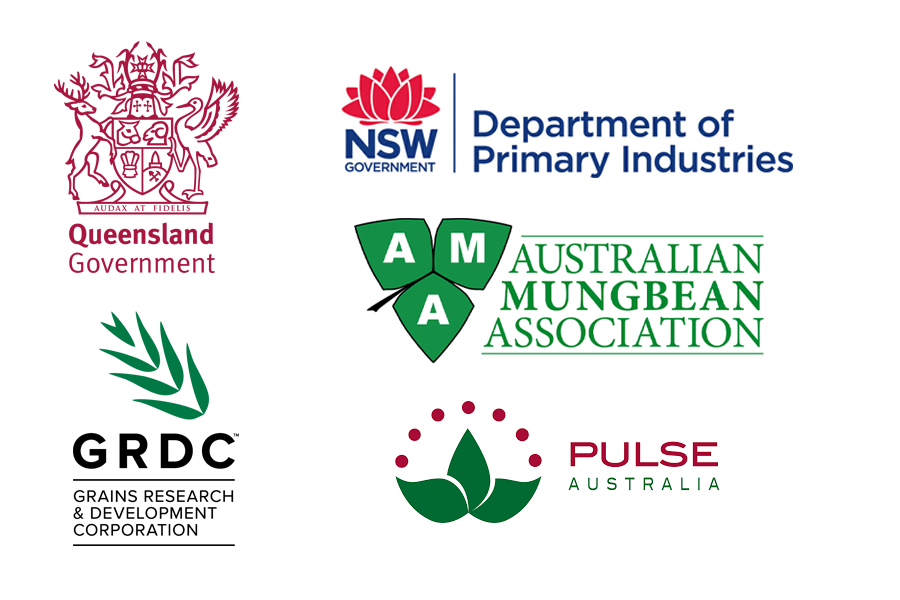Phytoplasma (a specialised bacteria infecting plants) has been widely reported in spring-planted mungbeans from Central Queensland to North Western NSW (Moree and Narrabri) and all areas in between. Symptoms include masses of small deformed leaves, flowers and pods, plants remaining green at harvest, and possibly an increased incidence of puffy pod.
While in previous recent summers, moderate to high levels of infection in mungbeans have been mostly in the Springsure, Orion, Gindie and Rolleston regions of Central Queensland, this summer the disease has been reported in most mungbean growing regions. Last summer there was also a severe but localized outbreak in soybeans on the central Darling Downs and reports from the Riverina. This year there has been a report (to be confirmed) of low levels of phytoplasma (<0.01% as at mid Jan 2017) in a late-November-planted soybean crop at Narrabri.
Overall the guestimate is that this summer 40% of spring-planted mungbean crops have/had noticeable levels of phtoplasma, with infestations ranging from 1% to as high as 60%. While the majority are at the lower end of this range, these levels of infestation are far in excess of what has been traditionally experienced in mungbeans, where the majority of crops traditionally show very few (< 0.1%) if any noticeable symptoms. Similar very low levels of infection have been the norm in soybeans, which made last summer’s localised but severe outbreak all the more unusual. At this stage we still don’t know enough to determine if phytoplasma will remain an ongoing issue for future plantings. However the leafhopper which most likely vectors the phytoplasma, the common brown leafhopper Orosius orientalis, has been detected in infected crops this summer in Central Queensland and the Darling Downs.
This article shows what the symptoms look like, and includes a downloadable survey form so the extent and magnitude of the current outbreak can be more accurately determined. Note that the only accurate way to assess % incidence is to count the number of infested/uninfested plants in a given row length at different sites within a crop. Invariably first impressions just looking at a crop lead to an overestimation of the % infestation.
Phytoplasma symptoms
Symptoms are often ‘witches broom-like’ in appearance and often thought to be virus infections. In younger plants, symptoms have presented as masses of small cupped leaves on shortened stems (Image 1). In some of these mungbean crops at the seedling stage, the damage was initially thought to be inflicted by seedling thrips, but these symptoms (Image 2) are quite different (no masses of small cupped leaves) and the plants invariably grow out of them within 2-3 weeks.
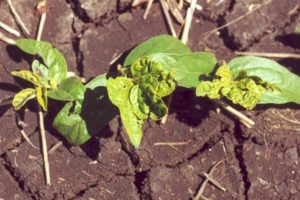
Image 2. Seedling thrips damage at Kingaroy November 1999. Note distorted leaves but not the small cupped leaves as in the previous image. Photo by Hugh Brier
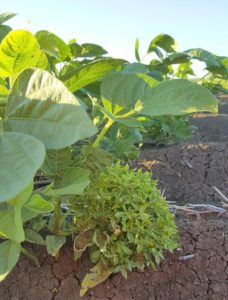
Image 1. Vegetative mungbean plant with distinctive phytoplasma symptoms – bunched small, cupped leaves. Photo by Kathi Hertel
In some crops, symptoms have not shown until flowering or early podding and have presented as masses of undeveloped flowers and small green pods (Images 3 and 4 mungbeans). On less affected plants, there may be normal pods that progress to the harvest-ready black pod stage in addition to the underdeveloped pods. However, the presence of massed immature green pod material makes harvest very difficult and can result in considerable yield loss.
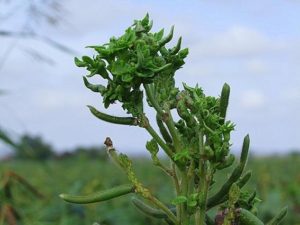
Image 4. Severe phytoplasma symptoms in podding mungbeans at Byee Qld. Note mass of small green deformed pods, plus normal undamaged pods on the same plant. Photo by Hugh Brier
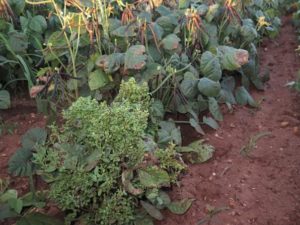
Image 3. Severe phytoplasma symptoms in flowering/podding mungbeans in Central Queensland. Photo by Murray Sharman
Similar symptoms were observed in soybeans last year, images 5 and 6, showing small green deformed pods, as well as more developed ones still green in May 2016 (they should have been harvest ready).
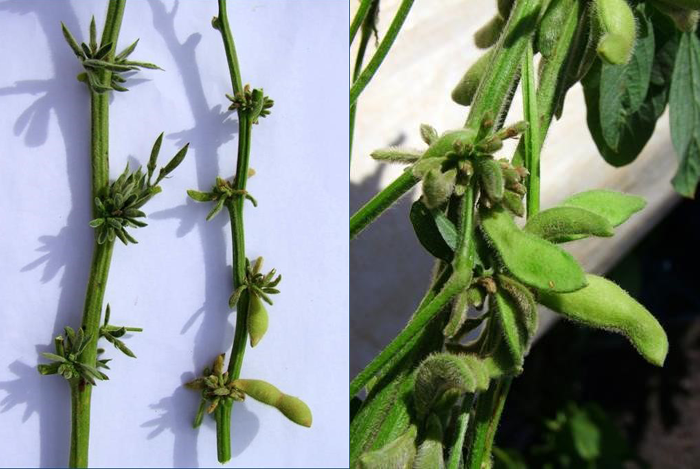
Images 5 and 6. Phytoplasma symptoms seen in soybeans 2016. Note the small deformed pods and the greenness of what should have been harvest ready (brown) pods. Photos by Hugh Brier
Of some concern is the increased incidence of phytoplasma diseases in other crops, including widespread incidence in pigeon pea, a probable new phytoplasma in papaya, and big bud phytoplasma in capsicum and tomato crops in southern Qld (Denis Persley pers. com). Last summer a virus outbreak was also observed in soybeans in the Lockyer Valley (Image 7). Note how the crinkly leaves in the virus-affected crop are different in appearance to the phytoplasma damage images.
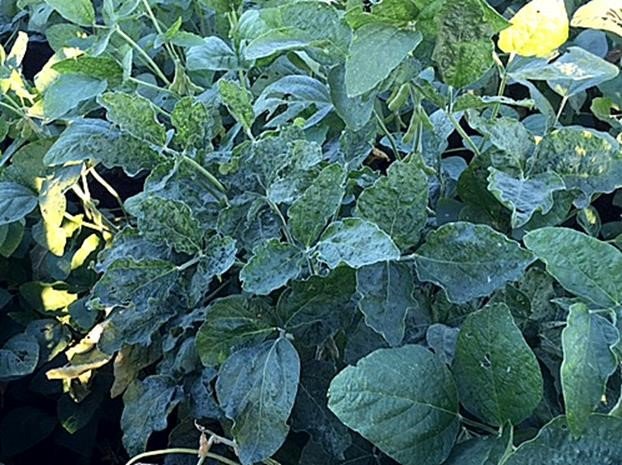
Image 7. Virus affected soybeans Lockyer Valley 2016. Note the crinkled leaves, which are quite different in appearance to the small leaves on the phytoplasma-affected plants. Photo by Murray Sharman
Disease agent and vector
In mungbeans, soybeans and pigeon pea, the phytoplasma most likely responsible is pigeon little leaf, which is most probably vectored by the common brown leafhopper Orosius orientalis – see Image 8. (Trebicki et al. 2010; Fletcher et al. 2016). While the vectoring capability of this species has to be confirmed in the current phytoplasma outbreak, brown leafhoppers were collected recently from a Central Queensland pigeon pea crop infested with phytoplasma, and also from infected mungbean crops on the Darling Downs. Note that some of the specimens collected were paler than the specimen in image 8, so colour alone may not be an accurate guide to their ID. The message is to collect any leafhoppers in the crop so we can be aware of what leafhopper species are present and how to differentiate between the most-likely vector species Orosius orientalis and other non- threatening leaf hopper species.
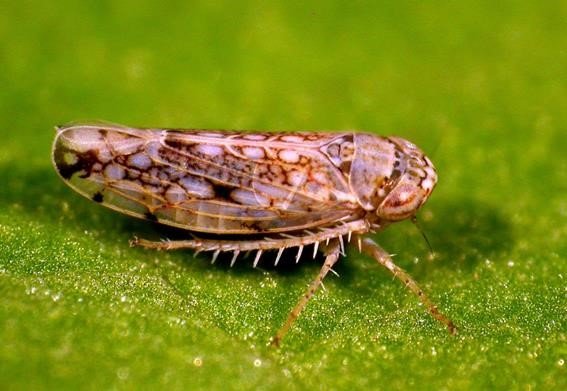
Image 8. Common brown leaf hopper Orosius orientalis, 3-4 mm in length. The literature suggests this is the most likely vector, but other leafhopper species may be responsible. Photo by Piotr Trebicki
Currently, the cause of the increased phytoplasma outbreaks is unknown. A possible reason is that spring rains favoured weeds that host the leafhopper. Other alternatives are that the phytoplasma has changed its physiological requirements (meaning it can infest and survive in different and more plants), or that additional insect vectors are transmitting the disease. As mentioned above, a potential vector, the common brown leafhopper Orosius orientalis, has been confirmed from infected crops in Central Queensland and the Darling Downs.
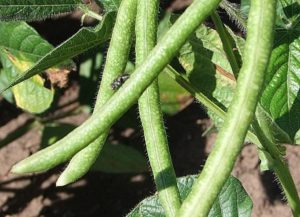
Image 9. Puffy pod symptoms (pod mottling) in mungbean crop heavily infested (35% of plants) with phytoplasma. Note that the insect on the pod is a parasitic fly, not a leafhopper. Photo by Hugh Brier
There is also a possibility that phytoplasma may be linked with puffy pod. In one crop heavily infested with phytoplasma (35% plants affected), there were also a significant number of pods with puffy pod symptoms (mottled pod exterior – see Image 9). Interestingly these puffy pods tested positive for phytoplasma; something we should keep in mind if there are other outbreaks of this symptom.
At this stage it is unclear whether spraying for the hoppers would prevent the transmission of phytoplasma. Experience with other insect-transmitted diseases suggests sprays are ineffective as the insect only has to feed once to infect a plant. As well, very few insects are required to spread the disease and by the time they are noticed the damage is done. If any sprays are applied, we would strongly suggest leaving sizable unsprayed strips to evaluate the effectiveness or otherwise of the sprays.
If multiple prophylactic sprays of non-selective insecticides are applied, there is a risk of flaring of other pests, particularly mites, silverleaf whitefly (in soybeans), and helicoverpa. Increased outbreaks of the latter increase the risk of resistance developing to the two most effective caterpillar insecticides in pulses, namely Altacor® (chlorantraniliprole) and Steward® (indoxacarb). Resistance to indoxacarb in Helicoverpa armigera is now at 6.7 per cent, up from only 1.6 per cent in 2013-14. Of concern are the very low but detectable levels of resistance to Altacor that are being detected by the CRDC resistance management group led by Dr Lisa Bird.
Clearly the distribution and severity of the current outbreak needs to be monitored. Please report all infestations to one of the people listed below:
- Hugh Brier – Senior Entomologist, DAF Kingaroy PO Box 23 Kingaroy Q4610, Ph 07 4182 1840,
Mob. 0428 188 069, Email [email protected] - Liz Williams – Entomologist, DAF Kingaroy PO Box 23 Kingaroy Q4610, Ph 07 4182 1818,
Mob. 0476 850 415, Email [email protected] - Murray Sharman – Senior Plant Pathologist, DAF Dutton Park Brisbane Ph (07) 3708 8499,
Mob. 0405 564 428, Email [email protected] - Lisa Kelly – Plant Pathologist, DAF Toowoomba 203 Tor Street, Toowoomba, QLD, 4350,
(Ph (07) 4688 1199, Mob. 0477 747 040, Email [email protected] - Paul McIntosh –Industry Development Agronomist, Pulse Australia Toowoomba.
Mobile 0429-566 198. Email [email protected].
Sending samples
Please send all phytoplasma and virus plant specimens (mungbeans, soybeans) to Murray Sharman at Level 2, EcoSciences Precinct Block C, 41 Boggo Road, Dutton Park QLD 4102 and any other disease samples (e.g. halo blight, tan spot, charcoal rot) to Lisa Kelly at DAF Toowoomba – 203 Tor Street, Toowoomba, QLD, 4350. Keep all collected samples cool (but do not freeze) and do not let them dry out. If collecting them into a paper bag, surround specimens with paper towel to reduce the rate of drying out, and place in a cooled esky. If collecting into plastic bags, surround specimens with paper towel to absorb excess moisture and keep cool. Send express post as soon as possible, or hand deliver in a cool esky.
Also collect any leafhoppers that are present. Keep cool in a ventilated container with a small amount of plant host material and express post or hand deliver to Hugh, Liz, or Murray.
To assist with reporting of the current outbreak, a survey form is also available for download, which can be returned to either Hugh, Liz, or Murray (or emailed to all 3 concurrently), or fax to (07) 4182 1868.
- Download survey as a pdf document (135 kB)
References:
- Fletcher, M., Löcker, H.,Mitchell, A., and Gopurenko, D. (2016). A revision of the genus Orosius Distant (Hemiptera: Cicadellidae) based on male genitalia and DNA barcoding. Austral Entomology (2016), 20 pp.
- Trebicki, P.; Harding, R. M.; Rodoni, B.; Baxter, G.; and Powell, K. S. (2010). Seasonal activity and abundance of Orosius orientalis (Hemiptera: Cicadellidae) at agricultural sites in South Eastern Australia. Journal of Applied Entomology Volume: 134 Issue: 2. pp: 91-97.
- Ceeney, S. (2016). Resistance on the rise in Indoxacarb. CottonInfo e-news. December 2016
Article by Hugh Brier, Murray Sharman, Liz Williams and Lisa Kelly, Queensland Department of Agriculture and Fisheries.
This work has been supported by QDAF, NSW DPI, AMA, Pulse Australia and GRDC.

